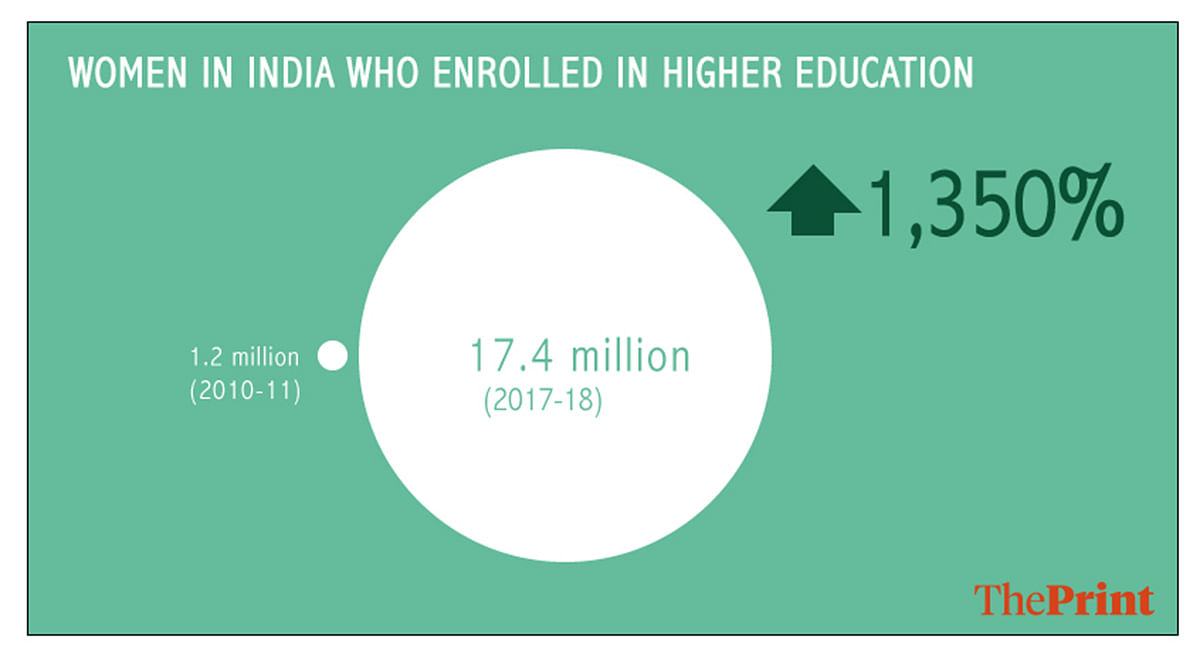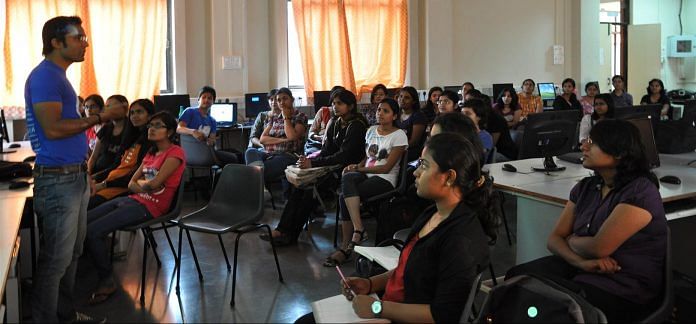Post-graduate and M.Phil. are dominated by women, but the nature of courses they’re studying hasn’t changed much over the years.
New Delhi: The number of women enrolling themselves for higher education in India has risen by a jaw-dropping 1,350 per cent in the last seven years, the All India Survey of Higher Education (AISHE) released Friday has revealed.
From 1.2 million women in 2010-11, the number has gone up to 17.4 million women in 2017-18. However, when compared to the percentage of women in the workforce in India, the number is abysmally low. As per the World Bank Report on Labour Force Participation, just about 29 per cent of women in India are part of the workforce.
Enrolment ratio
Of the total enrolment in higher education this year, girls constituted 47.6 per cent, which is up by around one per cent from last year. But in 2010-11, the figure was 44 per cent.
There has also been an increase of more than seven per cent in the Gross Enrolment Ratio (GER) of women in higher education in this period — from 17.9 per cent in 2010-11 to 25.4 per cent this year.

GER is a statistical index to determine the number of students enrolled at various levels, and is used to show the ratio of the number of students who live in that country to those who qualify for the particular grade level.
The overall GER is 25.8 per cent for 2017-18, while the GER for males is 26.3 per cent.
A massive leap
Interestingly, more women are enrolling themselves for post-graduation and M.Phil. courses than men.
In M.Phil. courses, nearly 70 per cent of students are female, while in post-graduation, they account for 60 per cent of the student population.
Nature of courses
However, there isn’t much change in the nature of courses that women are pursuing. More women are seeking admission in courses that have traditionally been considered women’s forte, like M.A., M.Com., M.Sc. (Nursing), Master of Library Science, Master of Physiotherapy, architecture, hospital administration and fashion management.
Courses like business administration, law, financial management and computer administration still continue to have more men than women.
At the undergraduate level, the stream where women have least representation is engineering and technology — they account for just 28.6 per cent of students.
Over 45 per cent women are enrolled in both science and arts courses.
Experts divided
Policy makers have given the credit for these positive numbers to policy intervention and affirmative action on part of the government.
“The number of women in higher education has been on a constant rise, and this is because of the policy intervention by the central government — such as scholarship schemes and transport facilities for women,” said S.K. Thorat, former chairperson of the University Grants Commission.
However, Manisha Priyam, who researches on education and social reforms, feels the journey is something that women have undertaken on their own, and what’s needed now is to provide them space in the professional sphere.
“Women have come this far on their own, which shows the self-willed motivation of women. It also shows that some of the policies that we have framed bore fruit. But the real story comes soon after this,” Priyam, associate professor at the National University for Educational Planning and Administration said.
“The upward mobility of women after this (higher education) is very low. I did a study which shows that the only place where women are equal to men are at the position of contractual labour; beyond that, at any position, men are far beyond. At the university level, women are only one fourth at the top level,” she pointed out.



